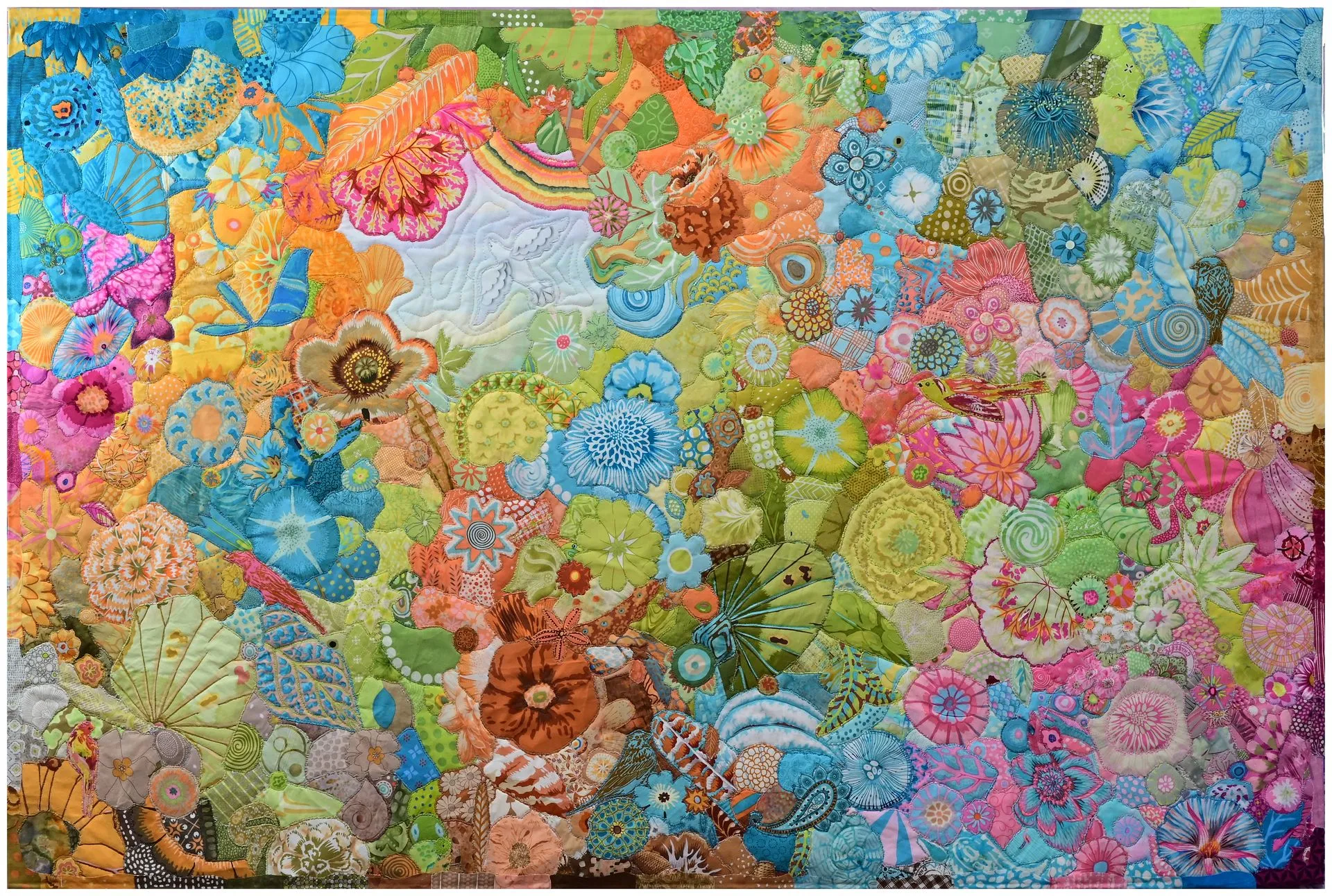From growing up surrounded by fabric in her parents’ clothing shops in the Netherlands to creating bold, joyful textile collages, Carly Mul’s journey with color and cloth feels meant to be. With a lawyer’s precision and an artist’s intuition, she’s developed her own freestyle approach to collage quilting—one where the fabrics seem to lead the way.
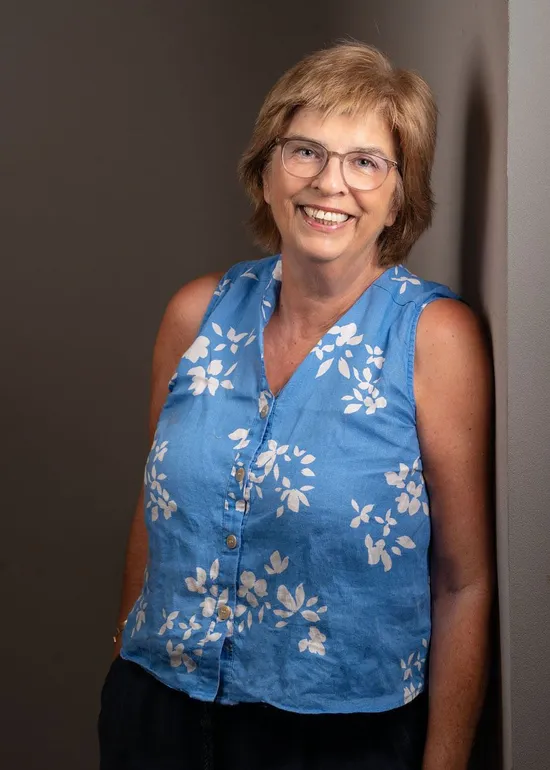
Tell us how your story with fabric began. Where did you first fall in love with textiles?
I am the daughter of clothing retailing parents who had thriving businesses in The Netherlands. My grandfather was a tailor.
As a child, I had to work in my parents’ shops, especially cleaning up. I loved putting shirts in color order. My crib was in fabrics! I actually considered taking over the business, but my husband was totally not interested. Since law gave me plenty of other opportunities that I liked as well, I thought I was done with fabrics… how life can change!
What did you do before quilting, and how did that time shape who you are as an artist now?
As an Amazon Associate I earn from qualifying purchases. Read more about our affiliate linking policy.
I am a (Dutch) lawyer by education and that has formed my thinking! I look for balance, reasonable solutions. I think in methods and in creativity at the same time. I like details and big lines and I think that is what law has taught me.
When you were young, what kinds of art or play did you do that feel related to your work today?
I could not draw. My “people” were terrible. I improved my grade to a B by scribbling lines and filling the spaces up with color. I could do that very well! I did that in Kindergarten. Now doing the same with fabrics!

Can you describe the first quilt or fabric piece that made you think, “I want to keep doing this”?
I saw the quilts exhibition for the Atlanta Olympics in1996 and was intrigued by the kindness of the quiltmakers. It sounded like a nice community. After that I looked for a class in Roswell GA. This was a traditional sampler class. I never looked back.
How would you describe your relationship with color in one sentence?
Color is my joy and therapy!
What made you decide to write Freestyle Color Collage Quilting?
As a teacher in Houston, I was walking around at Houston Market with my class quilt in my arms. A recruiter from Fox Chapel asked me if I could write a book. I said:”maybe I can” . That same night, she sent me a lengthy email about book writing. I started with the attitude of “Why not? Let’s give it a try”.
Writing comes easily to me; I have taught the class often, so I knew what to say. I enjoyed writing the book and was done with it more or less in 2 months. I didn’t like photographing the book, which was much more work!

How do you choose which colors go together when you’re building a collage? Any simple rules you use?
First of all, all colors can go together. There is not an impossible color combination.
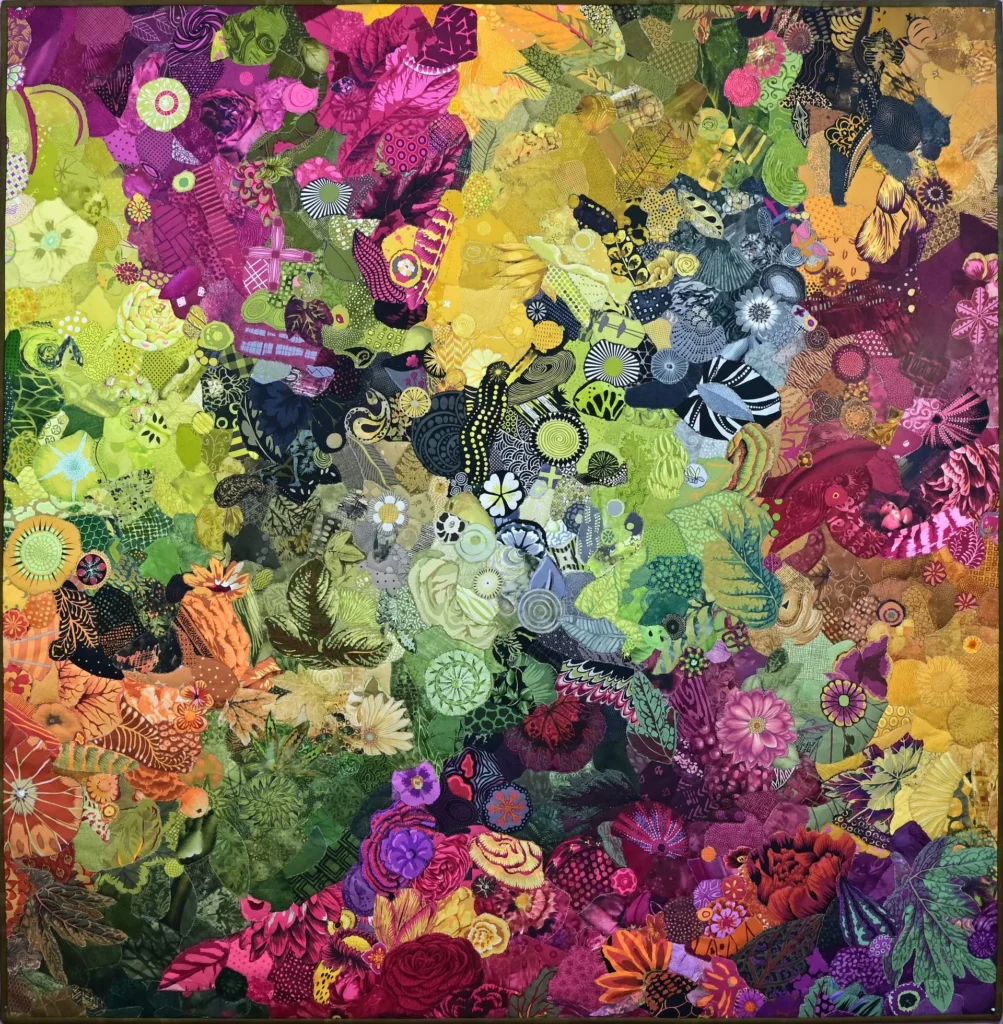
I make different kinds of collages: When it is a true freestyle color collage (like Abundance and Bouquet), I only have a few colors in mind. After that, the fabric decides which colors are going to be added. That sounds weird, but in my technique, it is a matter of closely looking at fabric to see which colors get introduced by a piece already used.

If it is a more designed collage (like Alzheimer’s or Rooted in color) I have a concept of design in my head.
The advantage of working with Lite Steam a Seam 2 is that you can reposition everything. That means you can try things. If I don’t like it, I move it somewhere else. There is an incredible sense of freedom in my collage and more than once the fabrics is making me something much better than my mind was planning.
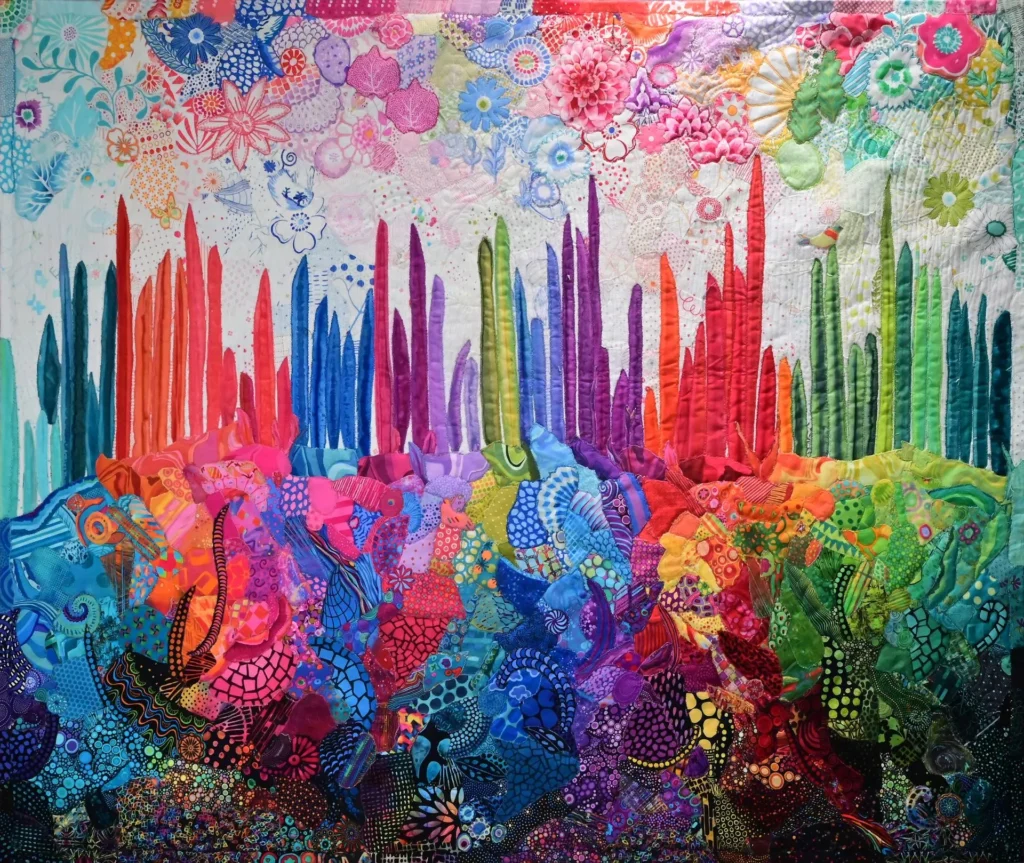
Do you plan designs first or let them evolve as you add fabrics? Which feels more like you?
As said: Both ways and sometimes a mix. I definitely communicate with my fabrics and try to “listen” to what it is telling me.
Describe your creative space.
I have the most fantastic studio in the basement of my house. It is about 2000 sq. ft. and it has everything I want. I have the big cutting table and checkout table from my shop. I knew long before I sold my shop that I was going to take good care of myself and bought the last years in business everything I remotely wanted to have.
Now I have all the thread lines I can imagine, scissors, needles, rulers etc. The only thing I still need to buy is fusible, but because I have started collagefabric.com, I can still order that at a wholesale level.
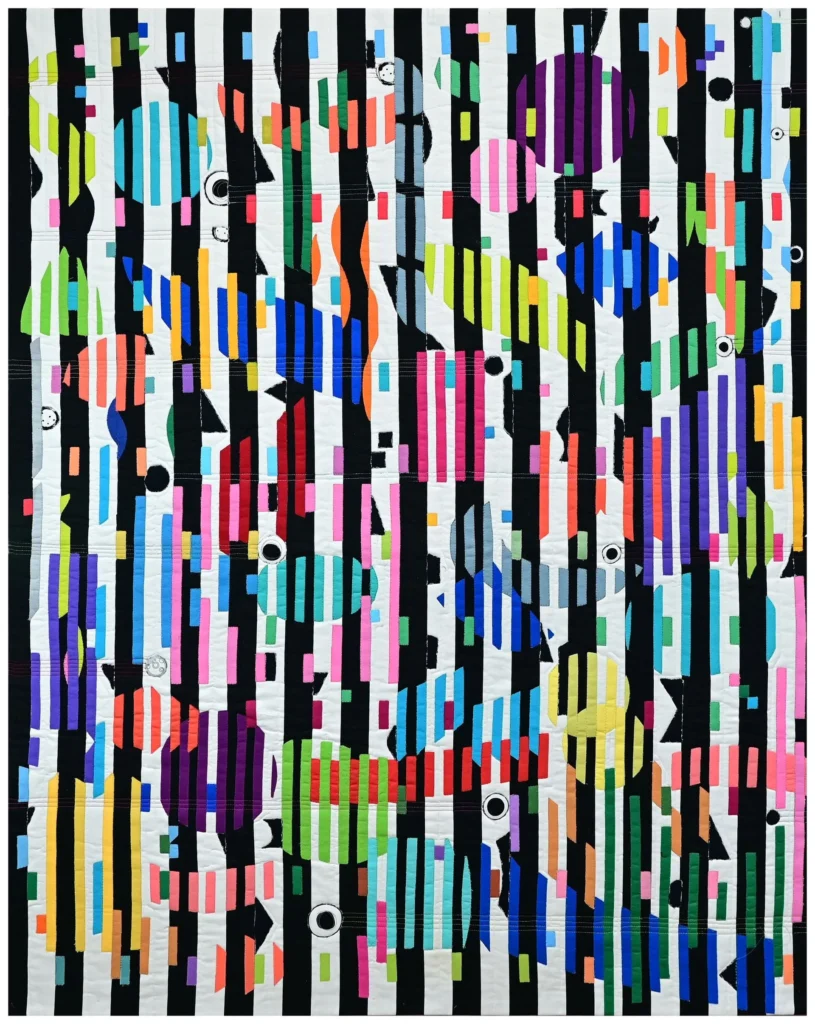
What’s your approach to using “ugly” or unexpected fabrics in a collage?
I actually don’t believe there are ugly fabrics. There are ugly-designed fabrics and ugly quality fabrics,. Ugly quality fabrics I won’t use, but when I don’t like a design, I cut it smaller and smaller until only color is left.
I like colors that are a mix of colors. I find them more interesting. I don’t care for primary colors. They are too much in my face. I do work with them, because I think it is good for me to work with all colors and I also know that many people just love those the most.
How do you decide when a quilt is finished? Is there a feeling or a visual clue you look for?
A quilt is finished when I run out of background material or collage material. It is much, much harder to make a larger size collage. I consider my quilts large as they are usually 40-45″, compared to what most people do (under 20″). In a larger collage one has to think about tension, balance, function of repeat of colors etc.
Often a quilt is ready because I have another idea in mind for the next one….It takes me about 3 weeks to make a quilt top and then another 4 weeks to quilt it (I only quilt in natural light between 10 am – 3 pm).
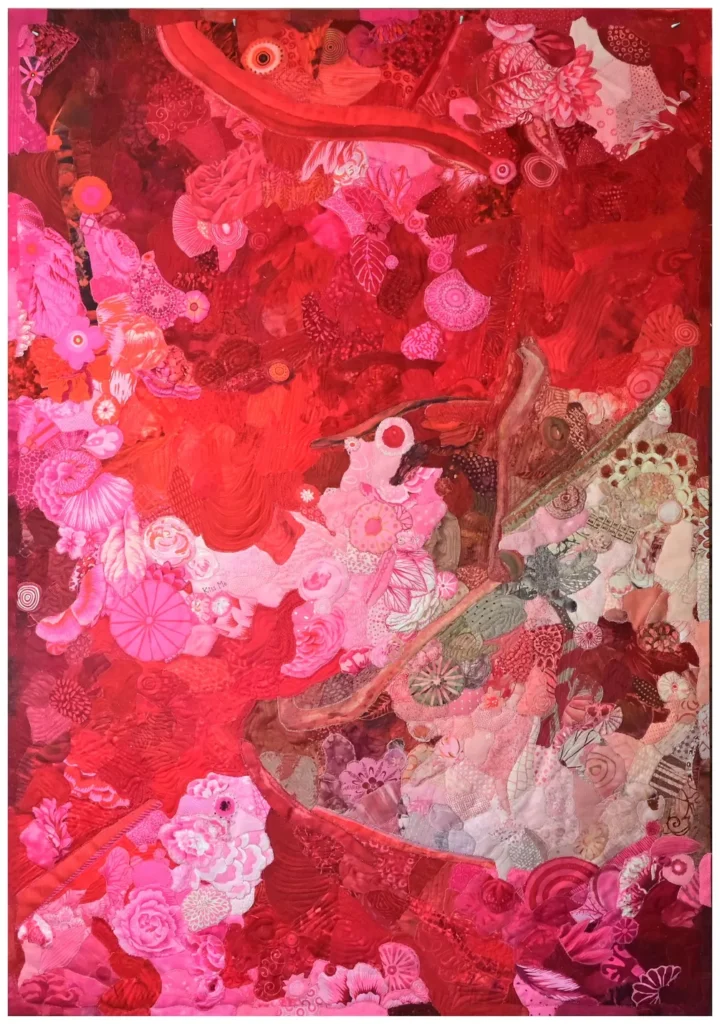
How has owning a fabric shop and working with fabrics for years changed how you choose textiles now?
I know the fabric industry very well and I am still buying fabrics that excite me. I don’t think my taste has changed over the years.
I like detail in colors, small steps in color changes. Big lines in colors! I love unusual colors and color combinations, but I know that that is the exception. When I make a work, I try to switch between (me) pleasing colors and not-so-pleasing colors. Most of the time I make a quilt for myself only, but I sometimes on purpose, try to make something that appeals to more people. Especially for classes.
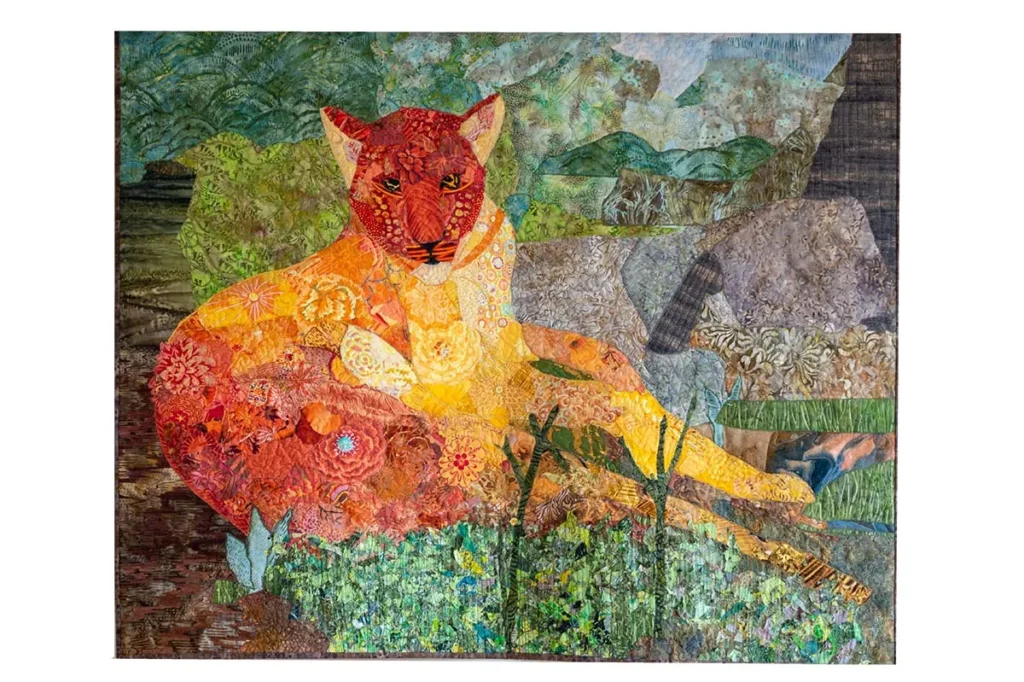
Tell us about a piece that taught you the most. What did you learn and how did it change your work?
Gypsy Wife, now called The Wanderer by Jen Kingwell. Up to that quilt, I didn’t know any better than making the same blocks for a quilt. That quilt taught me that you can have really different blocks in a quilt. Exciting.
Laura Heine’s pattern Lulu came out in 2014. I saw it at Market and made a shop sample. That pattern introduced me to collage. By now, I have made so many animals, flowers, photos that I am a little bit done with objects.
That’s how freestyle color collage came to life. I think colors are powerful enough by themselves to tell a story. No object is needed, at least not for me.
What role does improvisation play in your making? How do you keep it from feeling chaotic?
All my quilts are improvisated. I don’t like to make someone else’s work, it feels like I copy someone and I have no desire to do that.
Making lines in color brings some order to a work to begin with, but I have made quilts that felt too chaotic ,and I didn’t finish them. Those quilts have slowly dissolved by using the fabrics again another time.
I often have to “tighten” a collage up. In the process of making the lines, the lines are too swirly or too thin. I rearrange the fabrics and make fuller sections.

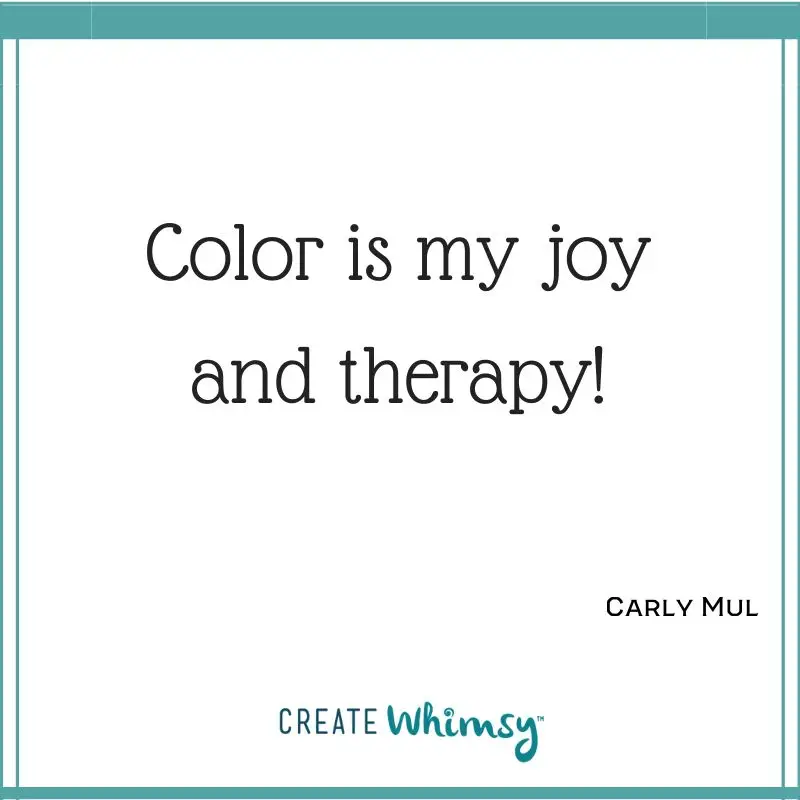
What’s one piece of advice for someone afraid to use bold color?
Don’t use it. You don’t have to use anything. Work with what pleases you. Fantastic pieces can be created with colors that are not bold at all. There are already so many bold pieces… looking forward to meeting your not-so-bold one!
Where can people see your work?
They can see my work on my website, in my book, at guild classes and sometimes at shows.
Carly’s website: https://www.carlymul.com/
Interview posted November 2025
Browse through more art quilt inspiration on Create Whimsy.

